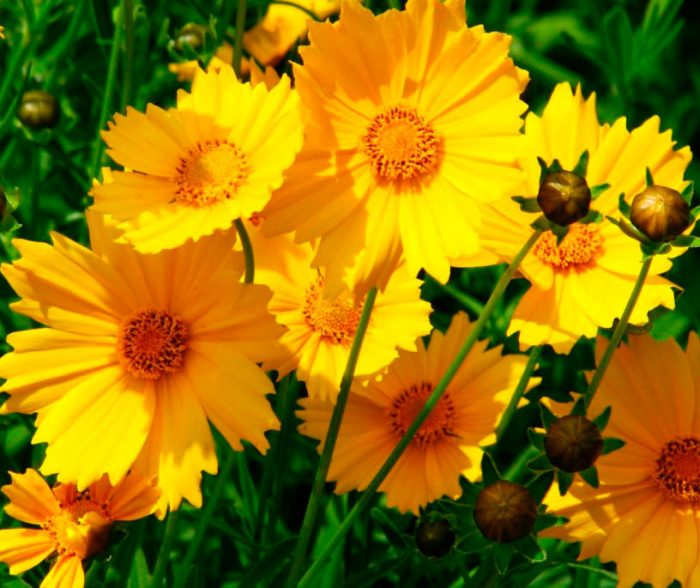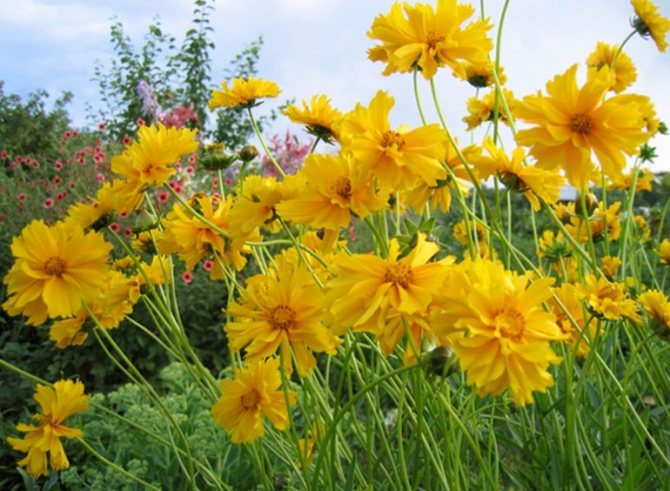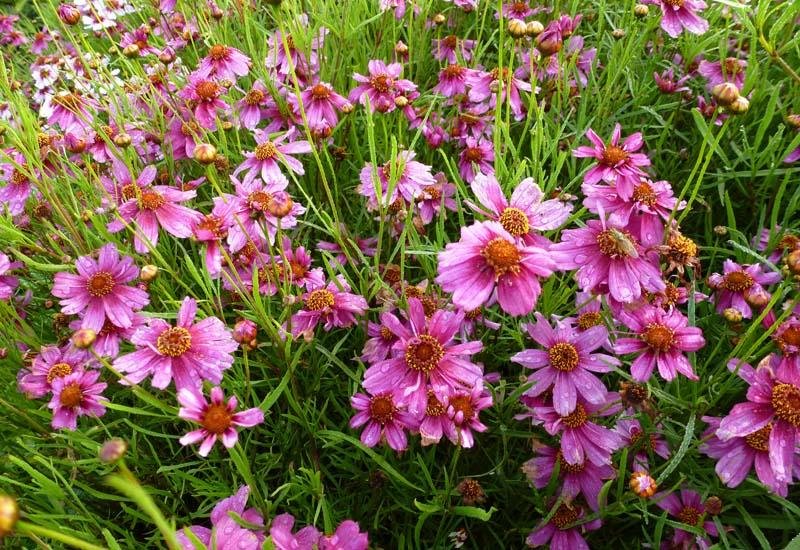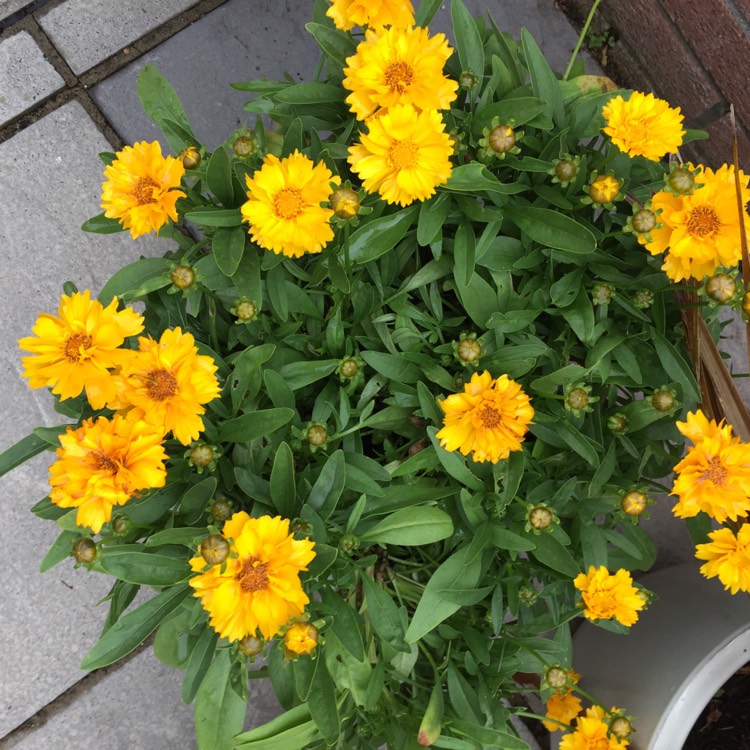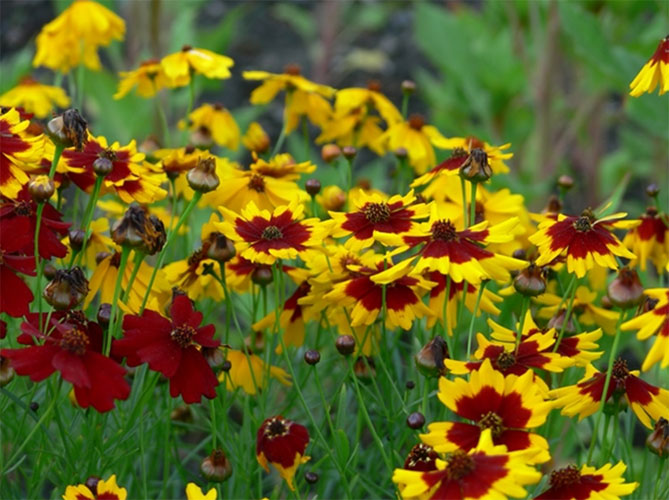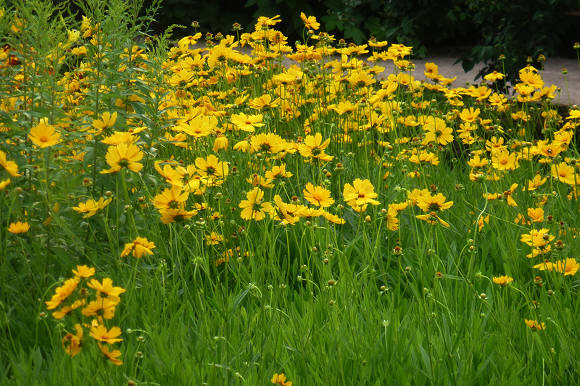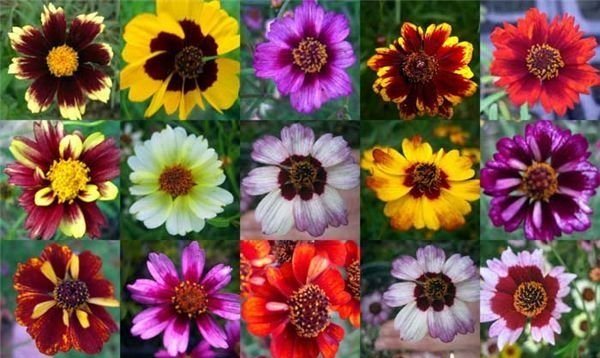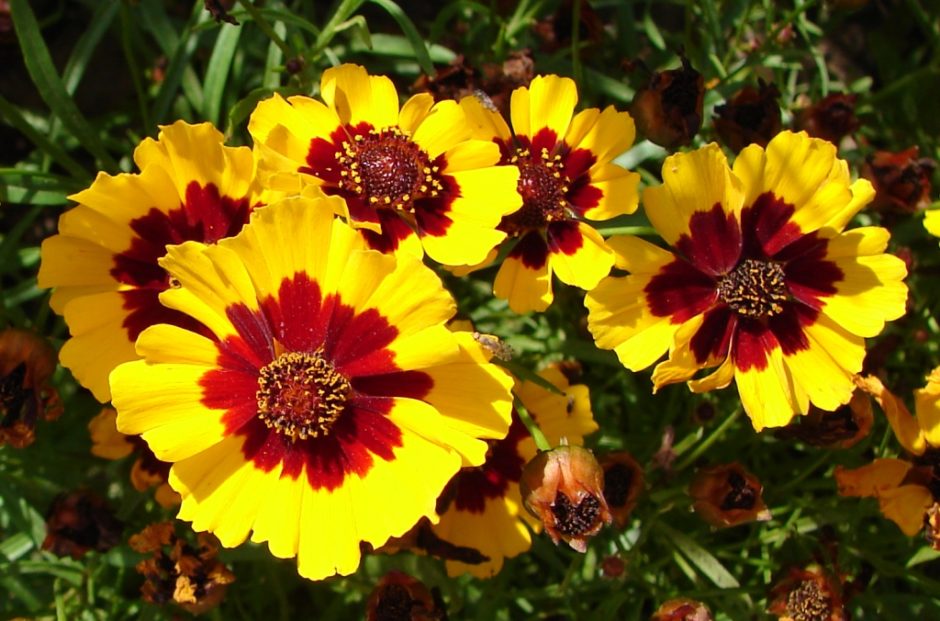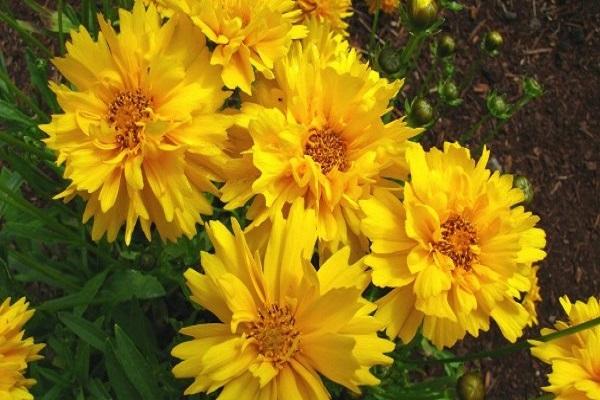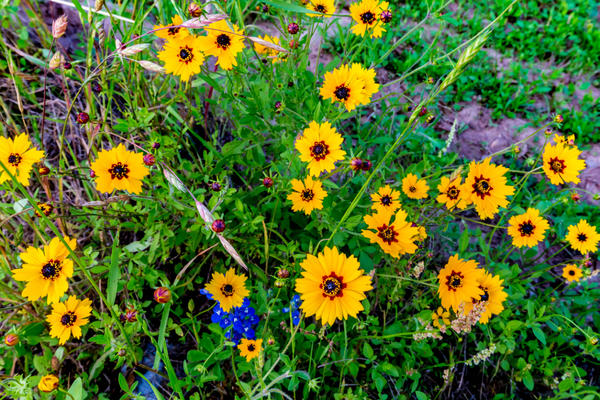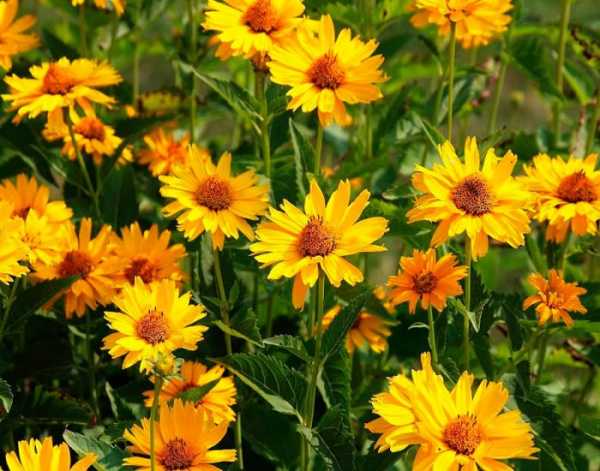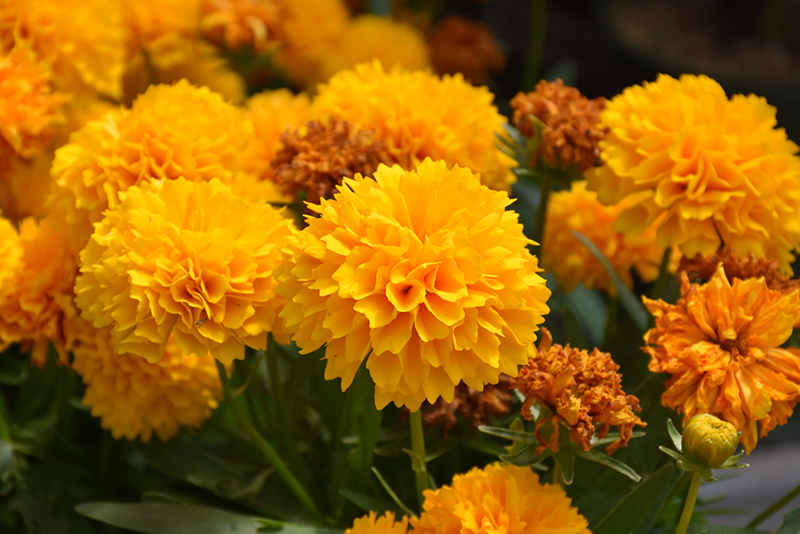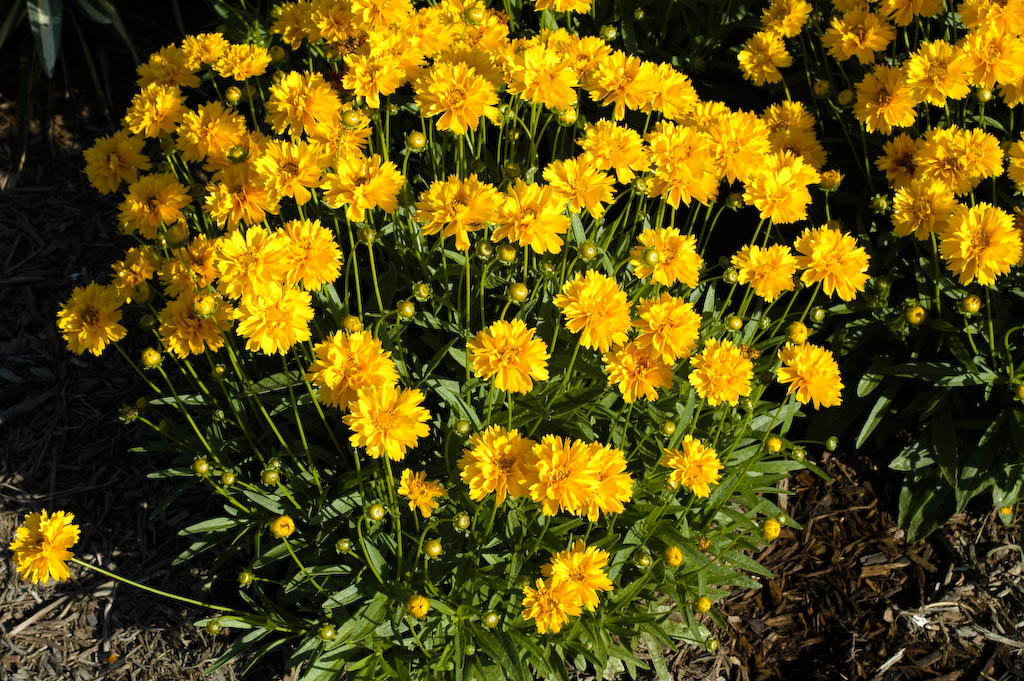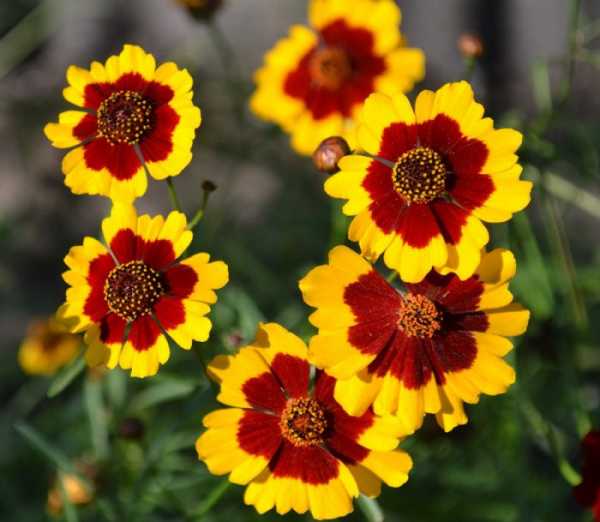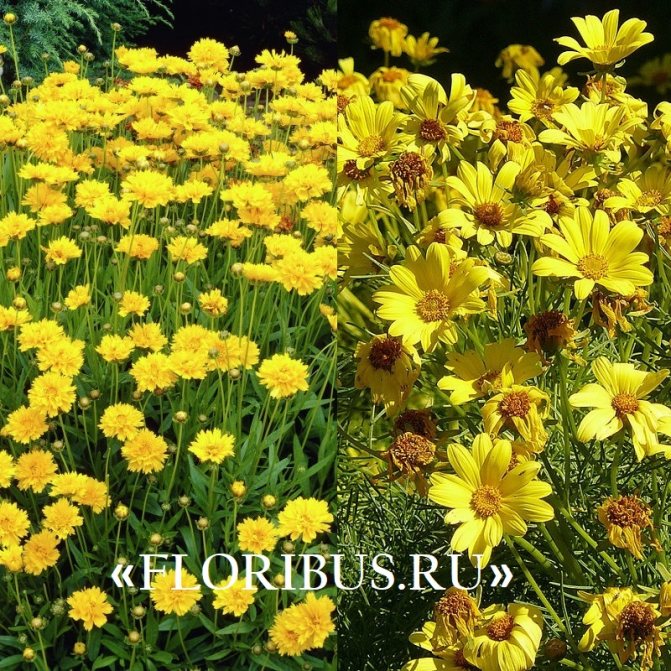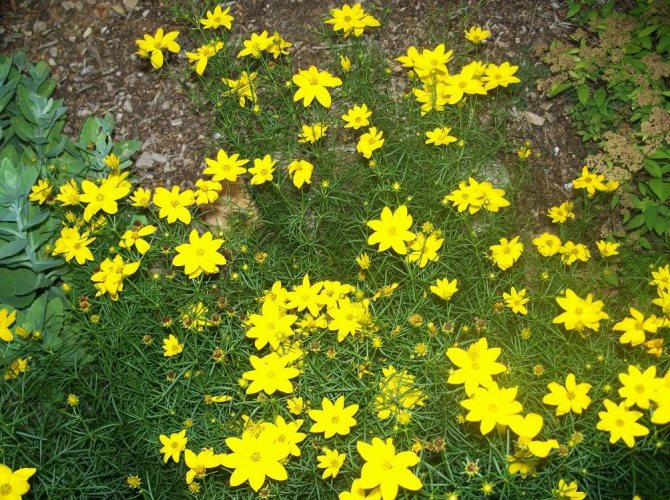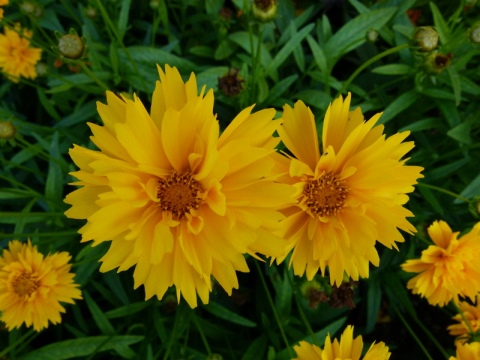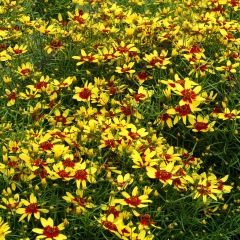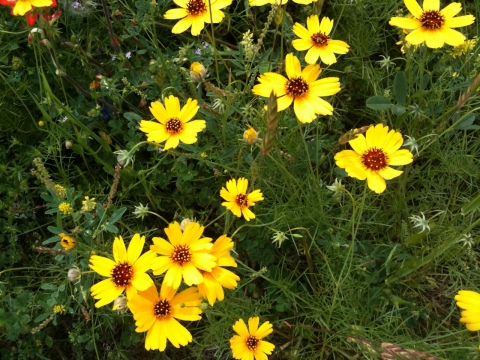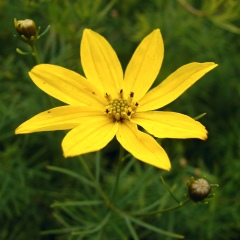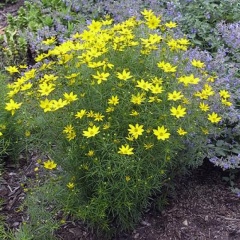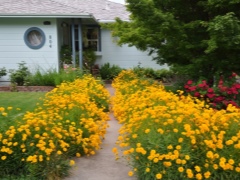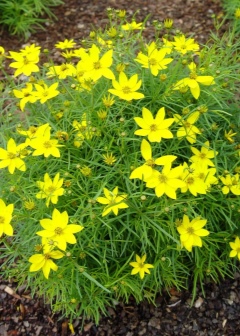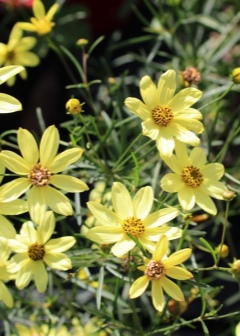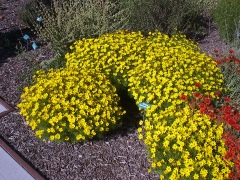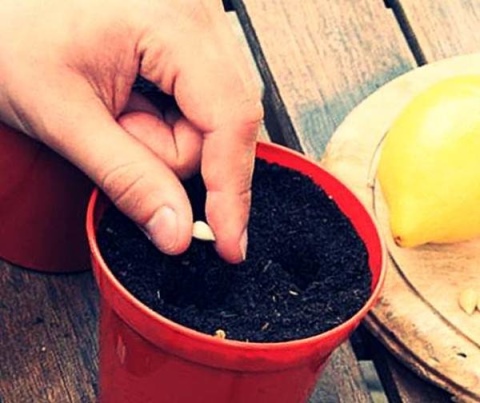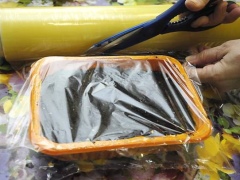Reproduction methods
If you decided to plant coreopsis on your site and were satisfied with the result, then the question naturally arises before you about how to properly propagate a flower and what methods exist.
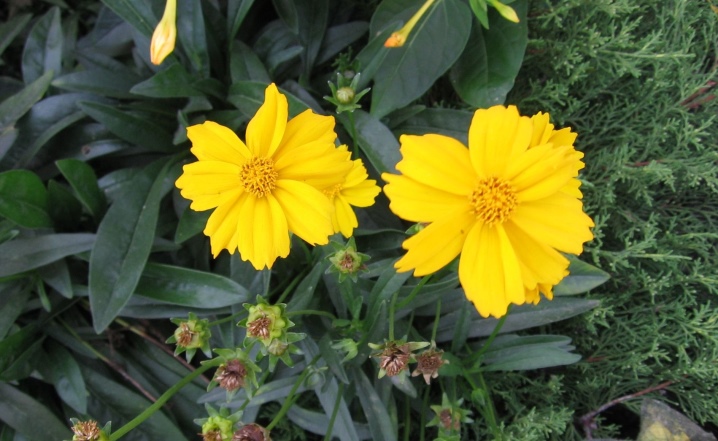
The easiest way to propagate the plant is by seed. However, it should be borne in mind in advance that this method will require a sufficient amount of not only your efforts, but also time. So, the most suitable season for planting coreopsis with seeds is spring or autumn. The most favorable spring month is April, and in the case of planting plants in the fall, they use the so-called podwinter sowing. It should be borne in mind that perennial plant varieties with seed reproduction will begin to bloom only after a year.
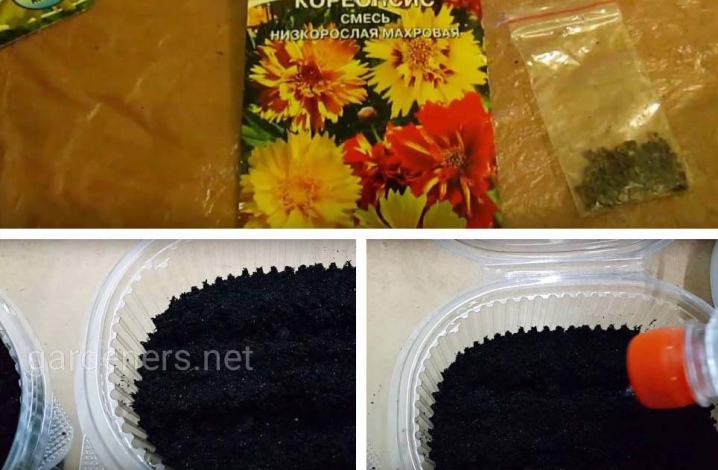
If you want the flower to bloom in the first year after planting, then you should use another method - sowing seedlings. This procedure is most often carried out in early spring, in March. For its implementation, it is necessary to prepare in advance special containers that need to be filled with a nutrient mixture from the soil. Seeds need to be placed in these containers (superficially, it is not recommended to bury them). Then the containers are covered with foil or glass. This will create the so-called greenhouse effect, respectively, accelerate the germination process. If you did everything correctly, then the first shoots of coreopsis will appear on the 10th day.
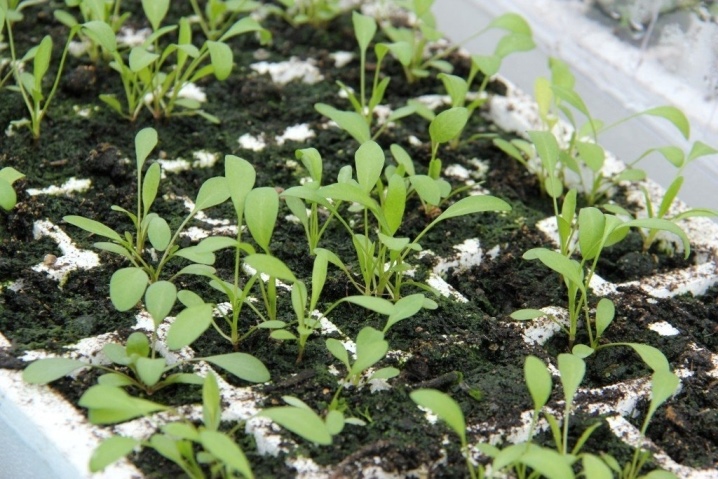
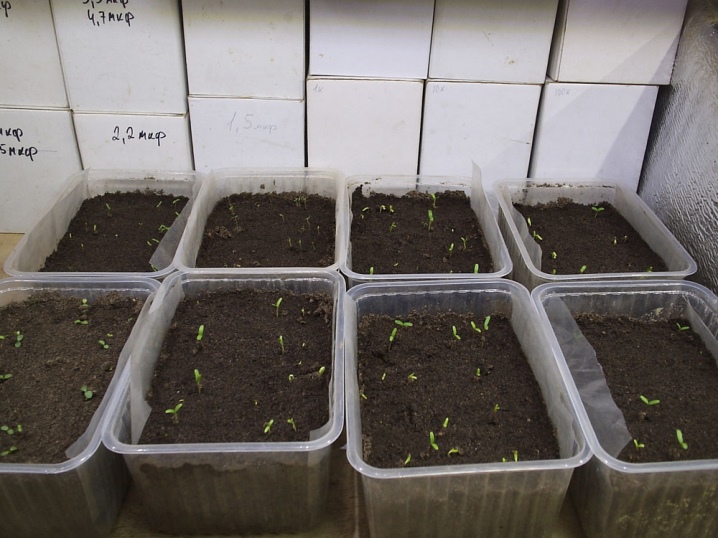
After that, you need to wait for the first leaves to appear. When this happened, you need to dive the seedlings. Remember that you need to plant plants at a short distance from each other (at least 2 cm). The box transfer is the first, but not the only one. After it, a second pick is carried out (at the moment when the flower reaches a height of 10-12 cm), but this time the procedure should be carried out by placing the sprouts in separate pots.
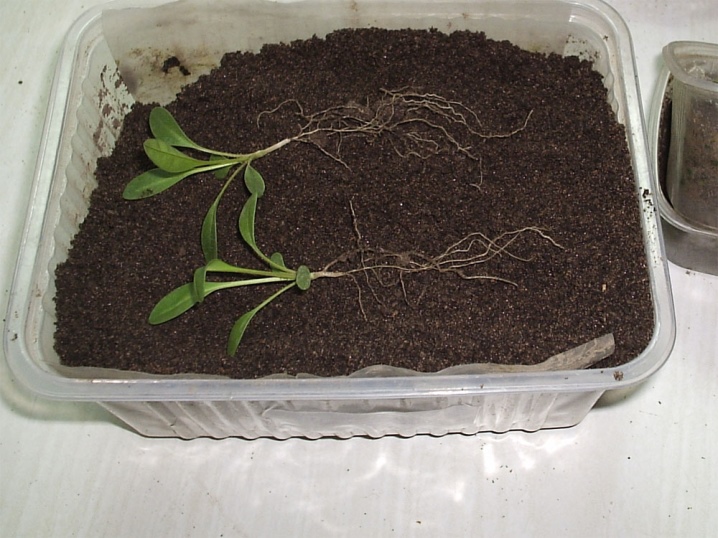
Experienced gardeners as well as botanical scientists warn that seedlings are prone to black leg (one of the diseases)
In order to avoid ailment, special attention should be paid to the watering procedure. So, in no case should you overmoisten the coreopsis.

Before planting grown seedlings in open ground, it is important to carry out one more procedure, namely hardening. To do this, pots with seedlings must be periodically taken out into fresh air, while gradually increasing the time the flower stays outside the room.
Coreopsis is planted in a permanent place in open ground in late spring, in May. It should be borne in mind that the distance between plants should be about 0.5-0.6 meters. Planting coreopsis using seedlings is most often carried out for planting a plant in an unfavorable climate (for example, in the north of Russia).

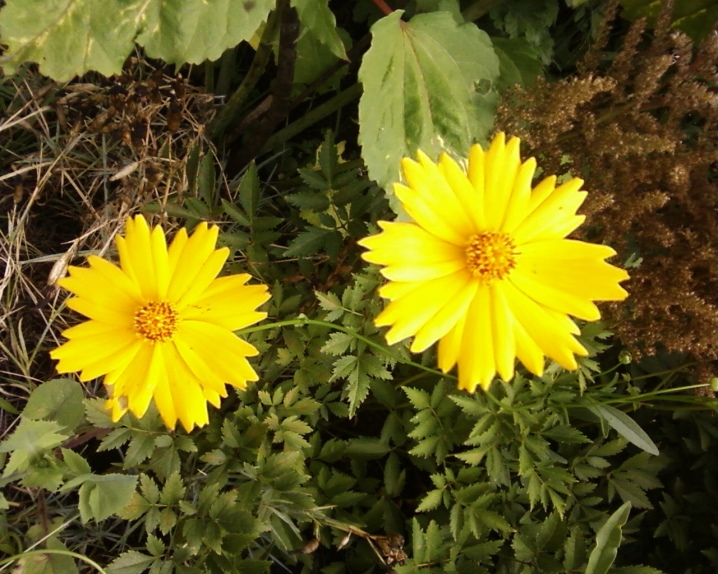
Another way is grafting. For this, cuttings are cut, placed in the soil and covered with a transparent cap on top. So rooting will happen faster. After a while, roots will appear, the plant will develop. Then you can remove the shelter.
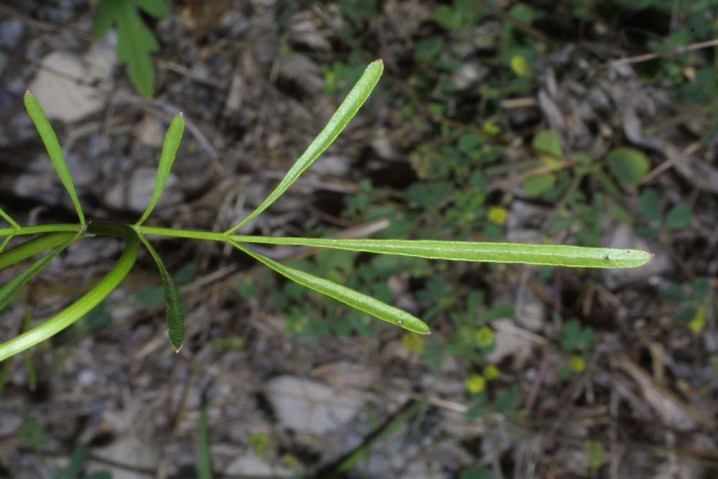
Possible growing problems
In adverse weather conditions, the plant can become a victim of fungal infections, as well as invasion of insect pests.
Leaf problems
On the bushes, you can find the following alarming symptoms:
- dry dark spots on the lower foliage - indicate septoria (Septoria coreopsidis);
- whitish stains are a sign of powdery mildew (Erysiphae cichoracearum);
- white spots on the inside of the leaves - downy mildew (Plasmopara halstedii).
If such lesions are detected, spraying with an antifungal drug, for example, Fundazol, should be carried out.
Pests
Most often, the flower is affected by aphids and leaf flies.They are easy to spot on coreopsis, just look closely at the bush. Helps against them spraying with a mild soapy solutionor an appropriate insecticide.
For reference! For aphids, you can apply Fitoverm, Aktar, Iskra-M and other drugs containing permethrin or aversectin.
Diseases
A common disease affecting coreopsis is rust. Its traces are easy to see on the leaves, covered with red spots, and then drying out. For prophylaxis, before the buds bloom, the planting is sprayed with a 1% solution of Bordeaux liquid or another copper-containing preparation.
Signs of improper care
A typical mistake of those who have not previously grown this plant is excessive feeding. Because of this, foliage grows quickly and abundantly, and flowers are reduced in number and reduced in size.
Note! With excessive bays, the foliage begins to wither, starting from the tips, and turn yellow. Caring for coreopsis is not at all difficult, many believe that it is enough just to plant it, and in the future it grows by itself
This is partly true, but still really large and beautiful flowers are obtained with regular feeding.
Taking care of coreopsis is not at all difficult, many believe that it is enough to just plant it, and in the future it grows by itself. This is partly true, but still really large and beautiful flowers are obtained with regular feeding.
Description of mukdeniya karasuba
This beautiful perennial came to us from Manchuria, northern China, Korea, although it grows in mountain forests around the world in subtropical and tropical zones. The leaves of mucdenia are similar to maple leaves, for which the plant received its second name - maple leaf.
The mukdeniya variety Karasuba belongs to the Ross species - one of two perennial varieties. This variety is also called "Crimson Fans", i.e. crimson fan. This name perfectly conveys all the beauty and elegance of this plant.
Maple leaf rhizome is close to the ground, dense, scaly and fleshy. Mucdenia has no stems. Leaves grow directly from the root, gathering in a heaped rosette. The leaf plates are thick, fleshy, 20-40 cm in size, located on a straight petiole. The mucdenia leaves are divided into 5-9 diamond-shaped lobes in the shape of fingers.
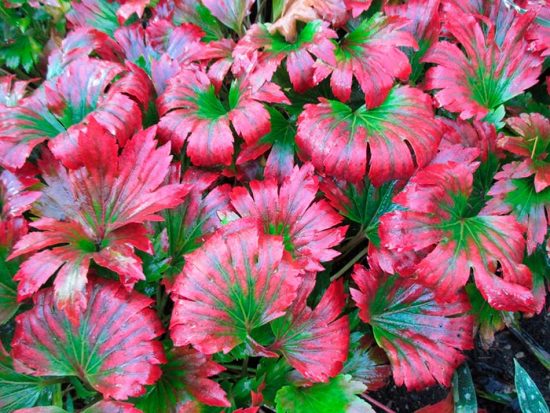
Over the course of several years, a perennial plant forms a curtain 40 cm in diameter. A beautiful carpet grows from the curtains of mukdeniya, which gradually and very effectively changes color from green to bright red during the growing season.
The flowering period of the karasuba mukdeniya is May. In the maple leaf, white or creamy medium-sized asterisk flowers are collected in branched inflorescences and placed on long (50-60 cm) legs. Leaves of a bronze-green color have not yet formed by this time. At the end of flowering, two-horned capsules form on the flower-bearing legs - fruits with numerous seeds. By this time, the leaves become dark green, with a bright red edging along the edges.
Coreopsis in garden design
All coreopsis are extremely graceful. Baskets are medium-sized, floating on thin, flexible peduncles that can intertwine with each other or lean on neighboring plants. The tongues of flowers are bright, silky, glossy, most often of yellow shades, as if painted by the sun itself. The foliage of many species is delicate, light, creating an ideal background for flowers. They feel the naturalness and pretty attractiveness of meadow plants.
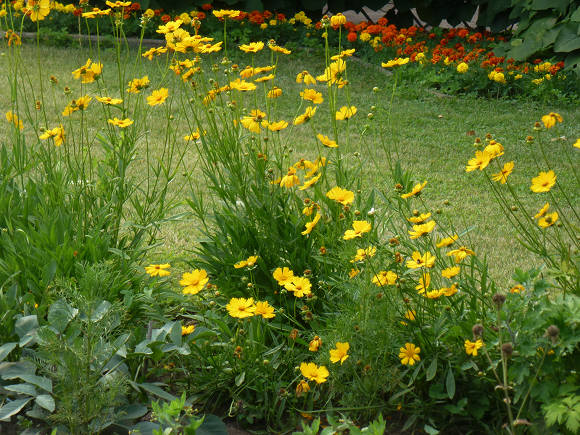
There are many ways to use coreopsis in the landscape. They look beautiful in groups on the lawn, in the lining of bushes, in the curbs along the paths and fences, in mixed flower beds. They successfully replenish the assortment of plants blooming in late summer - early autumn.
But these are plants not only for flower gardens.For example, verticulata coreopsis is especially suitable for planting in gravel gardens and goes well with feather grass and other grasses, as well as with the Caucasian poppy blooming at the end of summer, silvery plants - mullein, purse, and seaside cineraria. Yellow varieties are good to combine with blue catnip, blue and purple sage, veronica, delphinium. It is a recognized container plant.
Large-flowered coreopsis is a larger plant that will not get lost even among the brightest crocosmias, cannes, dahlias, red heleniums of the Moerheim Beauty or Rubinzwerg varieties. Low-growing varieties, for example, Zagreb with fern-like foliage and golden baskets, are also used for flowerpots and container compositions. Planting in containers is well tolerated by plants even in a flowering state, with a clod of earth.
Coreopsis large-flowered is distillable. To do this, wintering is organized for container plants at a temperature of + 3 ... + 5 degrees. Or left in the open air with a nonwoven cover. At the end of winter, the plants are placed in a warm, light room with a temperature of + 15 ... + 18 degrees. After 6-7 weeks, the plants will bloom. Distillation is also possible at lower temperatures, equal to + 10 ... + 15 degrees, but the period of distillation is lengthened.
Not everyone knows that corepses are excellent plants for country bouquets. The cut stays in water for more than a week. Terry varieties of large-flowered coreopsis are especially effective in vases.
Species and varieties of spuria irises suitable for growing in the middle lane
More than 600 different varieties of irises of the Spuria group have been bred, and the number of natural species is estimated at two dozen. But most species of plants require conditions that are not typical for our climate and will not be able to adapt not so much to frosts as to the peculiarities of summer, which must be hot, long and dry for them. Of the basic species for the middle zone, two species are considered the most suitable, which are also found in our country - Sogdian irises and salt-loving irises.
Salt-loving iris is a tall species, most often found on saline shores of water bodies, and in gardens it feels good in ordinary soil. Its peduncles reach 70 cm in height, up to 5 flowers bloom on them with different watercolor shades of yellow paint with greenish spots. It has decorative forms with golden flowers.
The Sogdian iris reaches a height of half a meter. This is a medium-sized spuria iris, the flowers of which are graceful, painted in pale blue or classic purple with yellow spots. It has beautiful broad leaves of a typical xiphoid shape with a pointed tip.
Among other species of spuria - oriental, Monier, false fake, Muslim, cereal, etc. - it is worth deciding on experiments only when the plant is already cultivated in your area and there are examples of its successful cultivation.
But when buying spuria irises, first of all, look for non-specific irises: preference should be given to modern hybrids, varietal specimens with proven qualities. The best candidates for decorating your garden are varieties already adapted from local nurseries or grown by local gardeners (then the chance of planting loss will be much lower). Hybrid varieties of spuria are less demanding on growing conditions, they adapt well to garden conditions and typical soils on flower beds. Although, even with the choice of proven varieties, the cultivation of spuria irises is carried out "by trial and error."
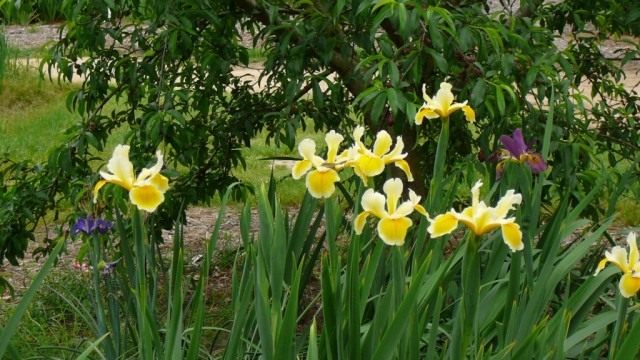 Irises spuria. Ron Killingsworth
Irises spuria. Ron Killingsworth
The best varieties of irises spuria:
- a snow-white with a yellow spot at the base of the perianths hybrid of the Eastern Iris "Phrygia" and other white varieties ‘Ila Remembered’ and ‘Highline Snowflake’;
- golden-flowered ‘Vintage Years’, ‘Sunrise in Missouri’ and ruffled Archie Owen;
- ‘Imperial Bronze’, as if cast from bronze, with a unique combination of bright yellow and dark veins;
- ‘Sultan’s Sash’ deep purple with surprisingly touching yellow veins on the outer petals and a similar lavender “Belize” pattern;
- ‘Missouri Rivers’ with a deep blue color and a beautiful yellow spot on the lower petals,
- 'Blueberry Sundae' with dark blue-edged lower petals, bright yellow eye and dark blue upper perianths;
- ‘Chocolate Fudge’, exquisite and watercolor, inviting to admire the transitions of golden and brown tones and also painted in brown ‘Red Oak’, ‘Cunnamon Stick’;
- bicolor Zamboanga with golden lower petals and reddish brown upper petals, adorned with beautiful veins and an unusual edge and similar but more brown ‘Sunrise in Sonora’;
- ‘Zulu Chief’ and more inky ‘Mighty Dark’;
- bright orange 'Sonoran Senorita' and 'Destination';
- lavender ‘Midrib Magic’, lavender ‘Innovator’ and lilac amethyst ‘Midnight Rival’;
- combining a bright yellow color and a white wavy border on the lower perianths with snow-white upper petals "Infini", etc.
Hybrids' Farolito ',' Missouri Gal ',' Twilight Mode ',' Larkspur ',' Sunny Day ',' Missoury Streams', 'Missouri Blue' and other "Missouri" varieties have also proven themselves well in regions with harsh climates, ' Golden Lady ',' Driftwood ', Lankaran, etc.
 Iris spuria, 'Cinnabar Red' cultivar. Derek Ramsey
Iris spuria, 'Cinnabar Red' cultivar. Derek Ramsey
7 diseases and pests
The flower is exposed to fungal diseases of various etiologies.
If the leaves of the plant are covered with rusty bloom or dark spots, then with 95% probability this means the beginning of the development of some pathology.
To combat, for example, a fungus, the bush must be treated with a special compound, and the affected areas with leaves must be removed in order to avoid the spread of the disease.
If spots appear on the leaves and inflorescences, then this indicates the presence of aphids on the bushes. Affected plants are immediately subject to disinfestation.
Some insects eat the leaves of plants. Slugs, beetles and other pests are manually removed from the bush.
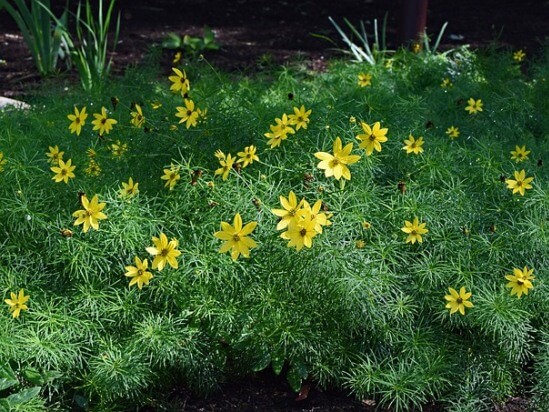
Common flower diseases:
Rust is a fungal infection that causes brown spots on the leaves. The damaged parts of the plant must be removed. The rest are to be treated with fungicidal preparations.
Spotting is a viral disease that causes curling of leaves, wilting of stems. There is no cure for this infection. The infected bush will have to be removed from the site and burned.
Fusarium is a fungal infection that is recommended to be treated with fungicides (Previkur, Fitosporin-M).
Wood ash tincture or citrus peel decoction can be used to fight with aphids, and if the case with pests is already completely neglected, then more serious substances, insecticides (Aktara, Karbofos) can help.
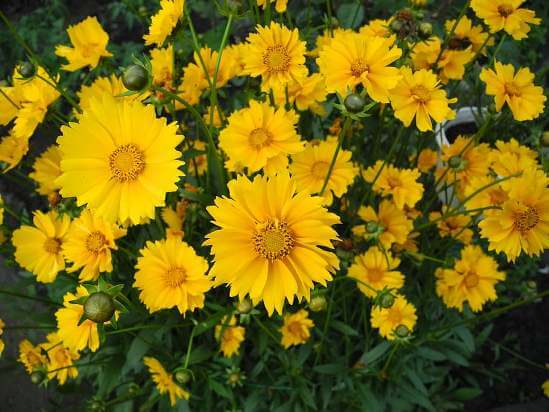
You may also be interested in:

